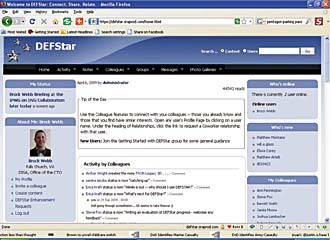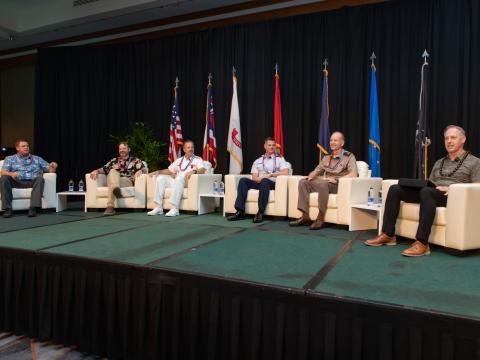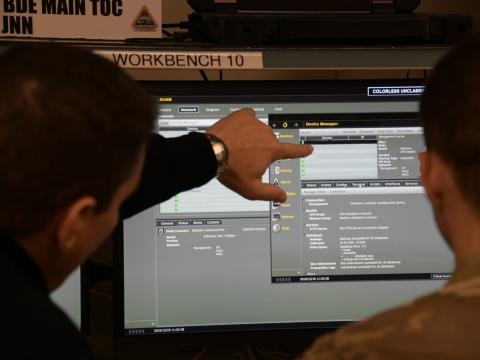DEFStar Shines Light on Networking
 |
The DEFStar social networking front page has a clean look that enables users to immediately see the information that is most important to them. |
While the dust has been kicking up around U.S. Defense Department social networking policies, the Defense Information Systems Agency has been actively pursuing one option that could address many challenges commercial sites pose. Hundreds of military and government personnel have been test-driving DEFStar, a commercially developed colleague network that resembles Facebook. From this pilot program, the agency hopes to find the middle ground between classified-only collaboration and the Wild West environment of the World Wide Web.
Brock Webb, computer engineer, Defense Information Systems Agency (DISA),
Rather than developing a social network from scratch, DISA turned to SRA International Incorporated,
Fox explains that his team decided to model the platform after similar commercial tools such as LinkedIn and Facebook. To keep the project cost down, SRA chose to tap into an open-source option, the Drupal Association. The organization comprises experts in content management who offer their talents by way of modules that can be fit together to provide the customized solution a specific group seeks.
To expedite the learning curve and therefore encourage adoption, the DISA-SRA team decided to provide a subset of capabilities that are considered classics to social networking, including the tools to create, share and search profiles. Fox explains that the terminology was changed slightly to reflect the purpose of the platform: instead of “friends,” individuals are referred to as “colleagues.” One reason for the adjustment was to garner the support of senior leadership, which may be turned off by using “friends” in a business environment, Fox shares. Membership currently is limited to .gov and .mil domain names.
Webb points out that one reason for exploring the technology was to find a way to enable colleagues to form relationships with co-workers—even those hundreds of miles away—who share the same skill sets and interests. “We are interested in spending thousands [of dollars] to serve millions of people instead of millions [of dollars] to serve several thousand people,” he says. “We wanted to know if we could we produce a ‘good enough’ system.”
Although dozens of content management software packages are available online, SRA decided to go with Drupal because it provides an open-source path, Fox explains. The association is a very active group of programmers that offers an open-source content management framework; this addresses many of the interoperability issues that arise when a proprietary solution is used, he adds. Social networking or Web page platform designers can choose from different modules to build the look and capabilities they want to offer their constituents. Hundreds of modules are available, Fox relates.
For example, DEFStar, which was launched in mid-April, has been designed to present the same type of options as Facebook. Users self-register, then create a profile and can add a picture if they choose. The profile can include information such as work history, current position, a job description and other interests. Community members then can invite colleagues to connect to them. Also similar to Facebook, the application sits in a user’s browser, and colleagues can add to the “wall” by talking about projects they are involved in or posting a call-out for solutions to a particular problem they are trying to solve.
Webb admits that success of the site was not a certainty. “This is a market-based approach. We want to publish lessons learned and share them with the [defense and government] community through sites such as Intellipedia to help the Defense Department make better decisions about social networking. When we began, we didn’t know if it would take off or fall on its face,” he shares.
Although the site was designed with the Defense Department community in mind, Webb emphasizes that other government organizations are welcome to tap into the capability. Some of the other federal departments that could benefit from the information sharing and “getting to know each other” features that DEFStar offers are the U.S. Department of the Interior and the U.S. State Department. When responding to an emergency, knowing someone via DEFStar can facilitate coordination, he explains.
Webb also points out that the site offers another communications means for government personnel who often move from one job or location to another. By making it easier to stay connected, DEFStar benefits the individuals and the government as a whole. “If I lose that connection, I’ve lost that value. We want as many people to come and use it as possible, because that makes the system more valuable,” he states.
DISA and SRA call the current version of DEFStar a demonstration or pilot program. During this trial period, members of the SRA team have asked the more than 1,600 participants on the site to offer their suggestions for ways to enhance the platform to make it more useful.
One recommendation the SRA team has heard several times is to increase the site’s security so that more information can be shared. Although entering the site requires a user name and password, those are currently the only security measures DEFStar requires.
Webb agrees with the users on this point. “One of the biggest barriers to adoption is that it is not behind a firewall. We don’t have a really good in-house product that we could use more securely to do more work-related communications,” he says. However, Fox allows that talk of making it a site that requires the use of a common access card in the future has taken place.
Webb also shares that DEFStar is in the process of being accredited to operate on the secret Internet protocol router network. Accreditation is expected early this year.
Another improvement users are interested in adding to the platform is instant messaging. Fox notes that DEFStar allows users to e-mail others both inside and outside of the system, but that participants are interested in real-time communications and the ability to see who is logged in while they are on the site.
In addition to giving participants the opportunity to offer suggestions, the SRA and DISA team has been monitoring DEFStar usage. The goal is not to snoop on conversations but rather to get a feel for how site members are using the capability and how they are learning from it, Fox emphasizes. In the process, the team learns lessons that can be applied to a possible future product, he adds.
Ad hoc group creation has been one of the most interesting aspects of the DEFStar demonstration, he adds. Users “flocked” to form communities of interest, some general, some social, Fox says.
One phenomenon that has surprised both Fox and Webb has been the average age of users. Both expected broad early adoption by personnel under the age of 30 even though 80 percent of the U.S. Defense Department’s civilian personnel population is over 30 and did not use social networking tools in the past. However, perhaps because DEFStar was designed to be user friendly by mimicking established commercial social media, the site’s population age profile matches the DISA personnel age profile very closely, Webb relates.
Fox concurs. “We thought we’d see a larger percentage of younger staff members, but our average user base is in their mid- to late 40s. We are pretty close to the age demographics of the Defense Department. We are conducting surveys to get information about what did or did not attract them to using DEFStar, and we are pursuing those areas. We don’t know the answers yet,” he explains.
On the viral front, Webb relates that one of the biggest challenges has been determining what will drive personnel to the site and then bring them back. A notification feature—informing users when others have joined the community—was added to assist in growing the community, but one goal is to have 50 or 60 of the same users log in every day.
Fox allows that one challenge is inspiring them to participate. Many users may check out what is on the site and observe but do not contribute to the dialogue. “We want to get people who are more than spectators,” he adds.
Although one reason may be that DEFStar is not a classified network, Fox believes that culture also plays a part in the reluctance. “The intelligence community is going through a revolution in information sharing—the Intellipedia revolution. But the Defense Department is still working on its policies regarding use of social networks,” he explains.
Webb agrees, noting that the department’s Web 2.0 usage policy is issued by the Office of the Assistant Secretary of Defense for Networks and Information Integration. Prior to any formal announcement, the security of the network relies on the standards of professional conduct and behavior that should be followed when using any open network, he says.
One barrier that must be crossed is the perception of social networking as playtime. This is not the case, Webb emphasizes. These sites are a means to forming meaningful relationships. “You may say, ‘Let’s go get coffee,’ but it’s all about getting to know people,” Webb states.
For examples of social networking benefits, he points to two studies: one involving lending money and the other involving health care. In the former, people were more likely to lend money to someone if they were able to get to know them through social networking. In the latter, doctors who saw a picture of a patient more accurately detected cancers. “It adds a human element that you don’t get out of e-mail. It is a better relationship because you know more about them, and you have an established relationship so you can get to work much quicker,” he offers.
The Defense Department will become more comfortable with social networking in the coming years, Webb predicts, and he looks forward to the time when DEFStar users will be able to tap into the network via mobile devices. “That is something that we are very interested in because we do realize that, based on the latest statistics I’ve seen, 80 percent of updates to Twitter are done from a mobile device. So, it’s a big marketplace. People like to do things on the go,” he notes.
Based on the report from SRA and Webb’s team at DISA, the Defense Department will assess how to proceed. One possibility is to make DEFStar a program of record, but the decision will be based at least in part on the results of the demonstration, Fox says.
WEB RESOURCES
DEFStar: https://www.intelink.gov/wiki/Defstar
Defense Information Systems Agency: www.disa.mil
SRA International Incorporated: www.sra.com
Drupal Association: http://drupal.org


Comments